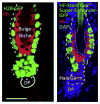Epithelial Skin Biology: Three Decades of Developmental Biology, a Hundred Questions Answered and a Thousand New Ones to Address
- PMID: 26970628
- PMCID: PMC5026047
- DOI: 10.1016/bs.ctdb.2015.11.033
Epithelial Skin Biology: Three Decades of Developmental Biology, a Hundred Questions Answered and a Thousand New Ones to Address
Abstract
The mammalian skin epidermis and its hair and sweat gland appendages provide a protective barrier that retains essential body fluids, guards against invasion by harmful microbes, and regulates body temperature through the ability to sweat. At the interface between the external environment and the body, skin is constantly subjected to physical trauma and must also be primed to repair wounds in response to injury. In adults, the skin maintains epidermal homeostasis, hair regeneration, and wound repair through the use of its stem cells. This essay focuses on when stem cells become established during skin development and where these cells reside in adult epithelial tissues of the skin. I explore how skin stem cells maintain tissue homeostasis and repair wounds and how they regulate the delicate balance between proliferation and differentiation. Finally, I tackle the relation between skin cancer and mutations that perturb the regulation of stem cells.
Keywords: Cancer; Epithelial; Hair follicle; Skin development; Stem cell; Stem cell niche; Sweat gland; Transcriptional regulation; WNT signaling.
© 2016 Elsevier Inc. All rights reserved.
Figures



References
-
- Ahtiainen L, Lefebvre S, Lindfors PH, Renvoise E, Shirokova V, Vartiainen MK, et al. Directional cell migration, but not proliferation, drives hair placode morphogenesis. Developmental Cell. 2014;28:588–602. - PubMed
-
- Andl T, Reddy ST, Gaddapara T, Millar SE. WNT signals are required for the initiation of hair follicle development. Developmental Cell. 2002;2:643–653. - PubMed
-
- Blanpain C, Lowry WE, Geoghegan A, Polak L, Fuchs E. Self-renewal, multipotency, and the existence of two cell populations within an epithelial stem cell niche. Cell. 2004;118:635–648. - PubMed
Publication types
MeSH terms
Grants and funding
LinkOut - more resources
Full Text Sources
Other Literature Sources
Medical

